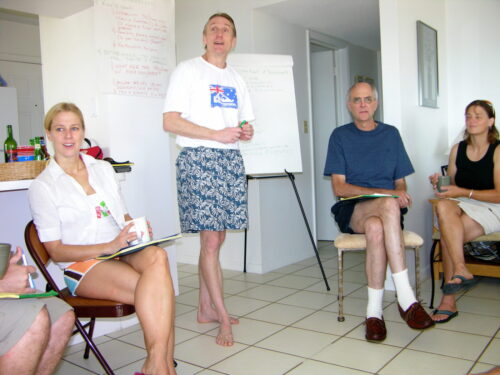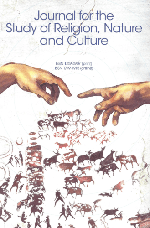Better Get to Know the ISSRNC (Part II) – Flashback Fridays
Several years ago our former communications maven Ipsita Chatterjea sat down with some of the ISSRNC co-founders to talk about the origins, guiding ideas and early years of the Society. For many of our new members, this may be a history you know little or nothing about. Even some of our longstanding members may not know the whole story about how the ISSRNC came into being in those heady, hurricane filled days of 2005.

Brainstorming the creation of the ISSRNC in Cocoa Beach (2005).
Below is an excerpt from Part Two of Better Get to Know the ISSRNC. In case you missed Part One, you can read it here.
Ipsita Chatterjea: Looking back, inasmuch as proposal submissions and the panels are some indication of the state of the study of religion and environment, what have you noticed as methodological and thematic trends?
Luke Johnston: Methodologically, I see an increasing emphasis on ethnographic data collection, and as in the academy more generally, a turn toward studying religious cultural production in specific geographical or cultural contexts. Thematically, perhaps predictably, attention has focused on increasingly global problems, especially climate disruption, but also biodiversity loss, and environmental justice and rights claims. These are issues where we find not just religion, but also economics, politics, and indigenous rights entangled. From an ethical standpoint, these increasingly global problems present a challenging landscape. These are just some of the areas in which the field has expanded in the past decade.
Bron Taylor: Additionally, we’re seeing increasing interest in survey and other forms of empirical research to test hypotheses, many of which have been advanced by ethnographers and historians. This trend illustrates the synergies between different methodological approaches.
IC: Could you talk to us about books or articles that have appeared in the last few years that the ISSRNC Executive committee and the ISSRNC board of directors and advisors recommend, or publications that embody ISSRNC’s editorial line, including those that either the ISSRNC or prior ISSRNC conferences have had some hand in producing?
Evan Berry: I will not refuse the opportunity to promote my forthcoming book, Devoted to Nature: The Religious Roots of American Environmentalism, due out from the University of California Press this July. This book theorizes the ways religious tradition has influenced the environmental movement in the U.S. and critically engages the vestiges of Christian theology that endure in contemporary environmental discourse.
BT: I hesitate to mention any because I would easily fail to mention equally important sources, including from society leaders and journal collaborators. But members of the society have full backward access to the nearly ten years of journal issues, which when combined with The Encyclopedia of Religion and Nature, provide leads to the wealth of scholarly literature that has been unfolding. It really depends on one’s interests. A new resource for discovering relevant research and cutting-edge scholars is Academia.edu. I would encourage people interested in this field to follow society members; this is a good way to get networked those who share your interests.
IC: How do you all see the study of religion and the environment shaping up over the next few years, what is its future?
Sarah Pike: Given the growth of environmental humanities and critical animal studies in recent years and increasing attention in the news media around global environmental issues such as climate change, the study of religion and nature will increasingly have an important role to play. As mainstream religious traditions, including the Catholic Church under Pope Francis, turn towards environmental issues and new religious and social movements grounded in spiritual commitments, such as radical environmentalism and contemporary Paganism, continue to express commitments to the Earth as sacred, our organization will be on the forefront of understanding these developments and communicating them to a broader audience.
You can read the full interview online here.












